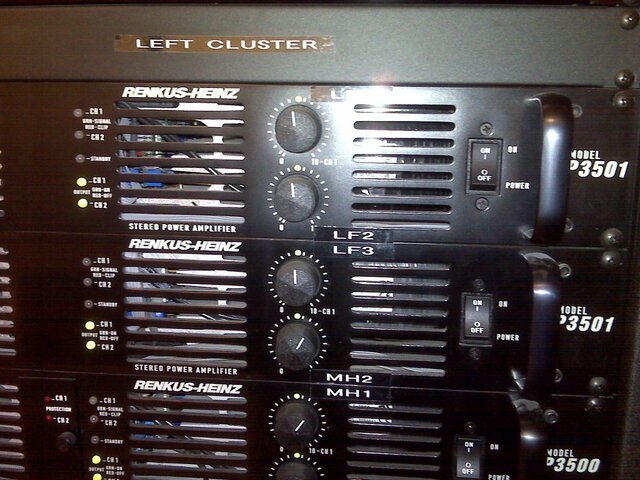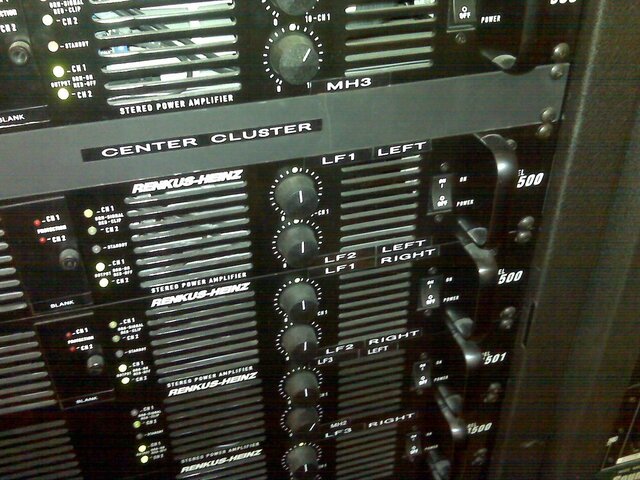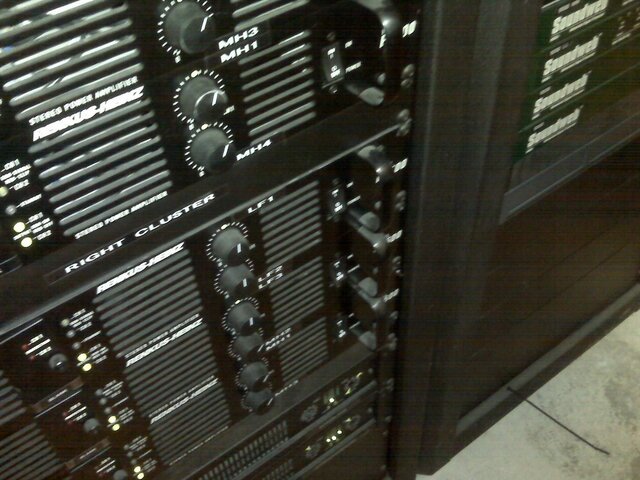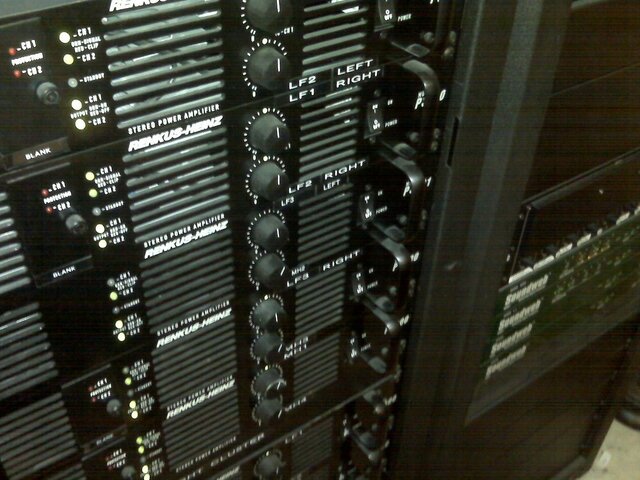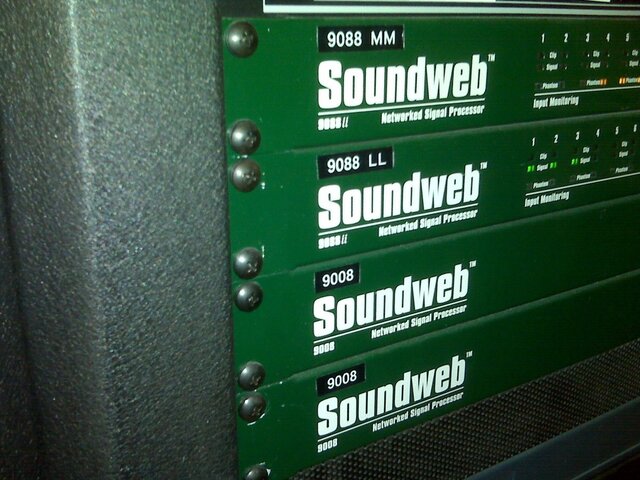Anonymous067
Active Member
I need help figuring out some stuff with our sound system. I need some speculations made on how this is most likely connected. Yes...I know this is a bad questions..but I've studied this stuff in and out, and can't figure it out. Here we go.
We have three clusters of speakers. All speakers are Renkus Heitz discontinued TRAP series. (Renkus-Heinz Inc. - Professional Loudspeakers)
As I suspect from my observations, they are laid out in this config:
Left cluster: 4 cabinets, three columns within that cluster, 1 left, 2 center, 1 right. The left and right I suspect are Trap40MK's, and the 2 center ones are Trap40K.
Right cluster: same as left.
Center cluster: 4 columns within that cluster, 1 left, 2 leftcenter, 2 rightcenter, 1 right. Again, I suspect the far left and right cabinets are Trap40MK's and the all four center speakers (middle columns) are Trap40k's. Clear as mud?
Our Soundweb DSP's put this out as an ouput:
"Left" Outputs...
1. Upper LF 1
2. Middle LF 2
3. Lower LF 3
4. Mid/High 1
5. Mid/High 2
6. Mid/High 3
"Center" Outputs...
1. Upper LF 1
2. Middle LF 2
3. Lower LF 3
4. Mid/High 1 & 4
5. Mid/High 2 & 3
"Right" Outputs
1. Upper LF 1
2. Middle LF 2
3. Lower LF 3
4. Mid/High 2
5. Mid/Hi (no typo) 1 & 3
Amplifiers...Renkus Heinz discontinued (so I presume) P3500 & P3501 series (cannot find web link).
"Left" Cluster
Amplifier (3501) 1...L-LF1, R-LF2 (wired into one cable, no idea if this splits at the cabinets)
Amplifier (3501) 2...L-LF3, R-MH2 (wired into one cable, no idea if this splits at the cabinets)
Amplifier (3500) 3...L-MH1, R-MH3 (wired...)
"Center" Cluster
Amplifier (3500) 1...L-LF1 Left, R-LF2 Left
Amplifier (3500) 2...L-LF1 Right, R-LF2 Right
Amplifier (3501) 3...L-LF3 Left, R-MH2
Amplifier (3500) 4...L-LF3 Right, R-MH3
Amplifier (3500) 5...L-MH1, R-MH4
"Right" Cluster
Amplifier (3500) 1...L-LF1, R-LF2
Amplifier (3500) 2...L-LF3, R-MH2
Amplifier (3500) 3...L-MH1, R-MH3
I gather that most of the outputs of the DSP go directly into the amps (they're labeled the same...so 1-1 patch type thing), that seems slightly obvious. For the record, all schematics are long gone, a man who thinks he owns the system has taken them (we actually had to change locks so he would quit taking things).
What confuses me is how on earth the amps are connected to the speakers. I don't have (and probably never will) have access to the speakers up close. Binocular view only folks...
My best guess is the larger cabinets are bi-amped?
Anybody have an intelligent guess?
I should also mention, no amps are operating in mono mode or bridge modes.
We have three clusters of speakers. All speakers are Renkus Heitz discontinued TRAP series. (Renkus-Heinz Inc. - Professional Loudspeakers)
As I suspect from my observations, they are laid out in this config:
Left cluster: 4 cabinets, three columns within that cluster, 1 left, 2 center, 1 right. The left and right I suspect are Trap40MK's, and the 2 center ones are Trap40K.
Right cluster: same as left.
Center cluster: 4 columns within that cluster, 1 left, 2 leftcenter, 2 rightcenter, 1 right. Again, I suspect the far left and right cabinets are Trap40MK's and the all four center speakers (middle columns) are Trap40k's. Clear as mud?
Our Soundweb DSP's put this out as an ouput:
"Left" Outputs...
1. Upper LF 1
2. Middle LF 2
3. Lower LF 3
4. Mid/High 1
5. Mid/High 2
6. Mid/High 3
"Center" Outputs...
1. Upper LF 1
2. Middle LF 2
3. Lower LF 3
4. Mid/High 1 & 4
5. Mid/High 2 & 3
"Right" Outputs
1. Upper LF 1
2. Middle LF 2
3. Lower LF 3
4. Mid/High 2
5. Mid/Hi (no typo) 1 & 3
Amplifiers...Renkus Heinz discontinued (so I presume) P3500 & P3501 series (cannot find web link).
"Left" Cluster
Amplifier (3501) 1...L-LF1, R-LF2 (wired into one cable, no idea if this splits at the cabinets)
Amplifier (3501) 2...L-LF3, R-MH2 (wired into one cable, no idea if this splits at the cabinets)
Amplifier (3500) 3...L-MH1, R-MH3 (wired...)
"Center" Cluster
Amplifier (3500) 1...L-LF1 Left, R-LF2 Left
Amplifier (3500) 2...L-LF1 Right, R-LF2 Right
Amplifier (3501) 3...L-LF3 Left, R-MH2
Amplifier (3500) 4...L-LF3 Right, R-MH3
Amplifier (3500) 5...L-MH1, R-MH4
"Right" Cluster
Amplifier (3500) 1...L-LF1, R-LF2
Amplifier (3500) 2...L-LF3, R-MH2
Amplifier (3500) 3...L-MH1, R-MH3
I gather that most of the outputs of the DSP go directly into the amps (they're labeled the same...so 1-1 patch type thing), that seems slightly obvious. For the record, all schematics are long gone, a man who thinks he owns the system has taken them (we actually had to change locks so he would quit taking things).
What confuses me is how on earth the amps are connected to the speakers. I don't have (and probably never will) have access to the speakers up close. Binocular view only folks...
My best guess is the larger cabinets are bi-amped?
Anybody have an intelligent guess?
I should also mention, no amps are operating in mono mode or bridge modes.
Last edited:



